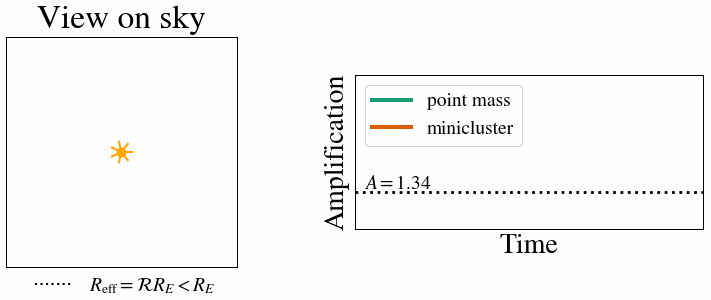Project Overview
In 2021, I completed my PhD at the University of Göttingen in Germany. My research focused on the formation of a particular dark matter structure known as axion miniclusters and whether we can detect them using a process called gravitational microlensing.
Dark matter
Most of the matter in the Universe is completely invisible to us. Furthermore, we know that it cannot be made from any type of matter we already know about (the so-called standard model particles).
One of the earliest pieces of evidence for the existence of dark matter came from the motion of stars around their host galaxies. Their motion is governed by simple Newtonian mechanics. This means that if we can measure the speed of a star's orbit, we can estimate the total amount of mass within its orbital sphere.
However, when we compare this predicted mass to the total amount of stars and gas we can actually see, we notice that this visible component falls significantly short. We can therefore infer that there exists some additional matter which we cannot see. We call this additional matter dark matter because we are unable to see it.
Additional evidence for the existence of dark matter include the motion of galaxy clusters, measurements of the cosmic microwave background (CMB) radiation and gravitational lensing.
To date, we have been unable to detect dark matter directly, however, we have some good ideas as to what it might look like. The three most popular candidates are weakly interacting massive particles (WIMPS), primordial black holes and axions.
Axions
The axion is a hypothetical particle that was not initially thought up as a way of solving dark matter. Instead, in 1977 Roberto Peccei and Helen Quinn predicted their existence as a way of explaining a different problem in particle physics known as the strong charge-parity problem.
It was only later that others noticed that this particle could be created in great abundance in the early universe. Since this particle would only interact very weakly with ordinary matter, this made it a perfect dark matter candidate! Since then, there has been great effort to detect the axion
Axion Miniclusters
The existence of the axion may cause weird objects to form in the very early universe such as axion strings and domain walls. These topological defects are very unstable and quickly decay and produce large quantities of axion particles.
At this point in time, there are no stars and no galaxies. Instead, the ordinary matter is still spread out evenly across space. However, the decay of these defects produces small regions that are densely populated by axions. These regions would collapse under the force of their own gravity to form what we know as axion miniclusters.
Today, these objects would have a range of masses from that of small asteroids to a few times the mass of the moon. They would also be very small and dense. Therefore, many believe we may be able to detect them using a technique called gravitational microlensing.

Publications
- Miniclusters Made Easy. In: Physical Review D. Vol. 103, No. 083525, 2021. arXiv:2006.08637
- Structure of Axion Miniclusters. In: Physical Review D. Vol. 106, Iss. 10 — 15 November 2022. arXiv:2204.13187
- Axion Miniclusters: Formation, Structure and Observational Signatures (PhD Thesis). doi:10.53846/goediss-9416
- Introduction to Dark Matter (Textbook). In preparation.
Presentations
- QUARKS 2020. Presentation: Understanding the formation and observational signatures of Axion Miniclusters and their substructure. YouTube video.
- Sixteenth Marcel Grossman Meeting (MG16). Presentation: Formation of Axion Miniclusters and their observational signatures.
- Cosmo21. Poster: Understanding the Formation and observational.